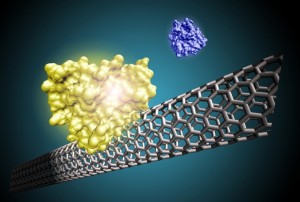Clinical laboratory managers and pathologists may see more testing shifting to point-of-care
For years, advocates of carbon nanotubes have predicted that this technology can be used to improve the accuracy and speed of clinical laboratory tests. Researchers at Oregon State University (OSU) now report that they have improved the speed at which a carbon nanotube-based bio-sensor can complete a diagnostic analysis.
Experts believe that advances in this area of technology will make it possible to perform routine point-of-care medical laboratory and pathology tests in minutes at a fraction of current cost.
The researchers at OSU used carbon nanotubes (CNT) to increase the speed of biological sensors. The news was posted on the university’s website. The OSU research team said that, when fully developed, the technology could eventually permit a physician to routinely and quickly perform medical laboraory tests in the office, enabling quicker diagnoses.
Charge-sensitive Nano-materials
Researchers at OSU used carbon nanotubes embedded in the surface of a capture sensor to detect target proteins. When the target protein lands on the CNT, the nanotube changes electrical resistance. The extent of the change in the resistance correlates with the nature of the target protein, helping to quickly identify it, according to a story in Medgadget.com.
“Electronic detection of blood-borne biomarker proteins offers the exciting possibility of point-of-care medical diagnostics,” wrote the research authors wrote their study, which was published in the journal Lab on a Chip. “Ideally such electronic biosensor devices would be low-cost and would quantify multiple biomarkers within a few minutes.”

Here is a carbon nanotube that is treated with a capture agent—shown in yellow. The capture agent can bind with and detect a target protein—shown in purple. This process changes the electrical resistance, enabling the creation of a sensor. Researchers at Oregon State University have shortened the time it takes for carbon nanotube-based sensor to identify proteins. This is a necessary step before these biosensors can be used in clinical laboratory testing applications. (Graphic copyright Oregon State University)
Examples of proteins that are detectable using the new nanotechnology include serum and ductal protein biomarkers that may indicate breast cancer.
Clinical Laboratory Test to Diagnosis in Minutes
The key to the new technology is the extraordinary capability of carbon nanotubes, the researchers noted. These carbon molecules are cylindrical in shape and have unusual properties. These include thermal conductivity, mechanical and electrical properties, as well as unique strength.
The OSU innovation was the discovery of a way to keep proteins from sticking to other surfaces. Essentially, by “greasing the pipe,” OSU researchers were able to increase the speed of the sensing process 2.5-fold, reported Omed.com in its story about the research findings.
“The development of biosensors using charge-sensitive nano-materials is an exciting new field,” wrote Ethan Minot, Ph.D., Assistant Professor, Department of Physics at OSU, at the Minot Research Group webpage on nanotube biosensors. He noted that many important advances have been made in the last five years, including adapting carbon nanotube devices for biological detection.
“With these types of sensors, it should be possible to do many medical lab tests in minutes, allowing the doctor to make a diagnosis during a single office visit,” Minot stated. “Many existing tests take days, cost quite a bit, and require trained laboratory technicians. This approach should accomplish the same thing with a hand-held sensor, and might cut the cost of an existing $50 lab test to about $1.”
The research was a collaboration among scientists in OSU’s Department of Physics, Department of Chemistry, and the University of California at Santa Barbara. It was supported by the U.S. Army Research Laboratory through the Oregon Nanoscience and Microtechnologies Institute.
In its study, OSU researchers stated that further work is needed to improve the selective binding of proteins before the carbon-nanotube-based technology is ready to develop into commercial biosensors. In addition to sensing the presence of proteins, carbon nanotube devices are being adapted for testing how well drugs bind to their targets, and for sensing disease markers at ultra-low concentrations.
Additionally, as reported in a previous Dark Daily e-briefing, research shows that innovative uses of carbon nanotube technology may prevent cancers from metastasizing. (See Dark Daily, “New Technology Captures Tumor Cells from the Bloodstream.”.)
At this stage, clinical laboratory and pathologists may consider this to be Star Trek-esque technology. However, each technology breakthrough brings us closer to the day when use of carbon nanotubes in biosensors may indeed provide a way to perform medical laboratory tests faster, with more accuracy.
—Pamela Scherer McLeod
Related Information:
Carbon Nanotube Biosensor Technology to Speed Up Medical Diagnostics



